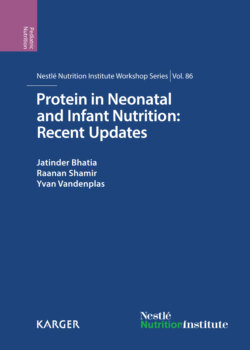Читать книгу Protein in Neonatal and Infant Nutrition: Recent Updates - Группа авторов - Страница 40
На сайте Литреса книга снята с продажи.
Nutritional Value
ОглавлениеImpaired growth in infants with food allergy may be related both to the disease itself, causing inadequate intake or compromised absorption, and/or to inappropriate nutrient content of the dietetic regimen. The maintenance of a nutritionally adequate diet is not easy, especially in more severe cases, but is mandatory [39]. In the first 4-6 months of life, formulas represent all and in the second semester of life about half of the nutrient source, and hence nutritional appropriateness is obviously mandatory to avoid short- and long-term health consequences [39]. For optimal utilization, the hydrolyzed protein source should respond to a precise pattern of indispensable amino acids with the branched-chain amino acids and valine representing around 50% of the essential amino acid quote [57]. AAFs are also diversified within the different types of formulas, with taurine practically being the only amino acid in SFs, while branched-chain amino acids and glutamate are the major amino acids in eHF [39]. In the GINI study, the longest prospective, randomized, double-blind trial of full-term at-risk neonates, eHF-C-fed infants showed a significantly lower gain in weight and BMI than infants fed the other formulas in the first year of life. No significant differences in weight and BMI were found among the other formula groups (pHF-W, eHF-W and CM-based formula) or the breastfed group over the entire period up to 10 years of life [58].
According to adult taste, there is an inverse relation between peptide size and palatability that can influence the amount of intake compared to non- or less-hydrolyzed peptides. In infancy, eHF-C determined a significantly more savory, bitter and sour-tasting preference as long as the infants were not weaned [39]. According to adult taste, rice hydrolysates taste better than CM-based eHFs.
